Headset vs Speakers: Comparing Sound Quality, Experience, and Value
Updated On: November 13, 2025 by Aaron Connolly
Key Differences Between Headsets and Speakers

Headsets put sound right into your ears with small drivers. Speakers, on the other hand, throw sound out into the air using bigger drivers.
This choice between personal isolation and room-filling audio really shapes how we experience games and content.
How Headsets and Speakers Deliver Sound
Headsets place small drivers just millimeters from your ears. The sound travels directly into your ear canal, making it feel pretty personal.
The left channel feeds your left ear, and the right channel goes to your right. With this setup, headsets nail stereo imaging.
Speakers do things differently. They push sound through the air with larger drivers, so the sound bounces around the room before it reaches you.
Loudspeakers create something called “crossfeed.” Your left ear picks up a bit from the right speaker, and vice versa.
This mixing feels natural. When you listen to live music or just walk around outside, both ears catch slightly different things.
Want to try it? Listen to the same song on both headsets and speakers. With headsets, the sound feels like it’s inside your head. On speakers, it’s coming from somewhere in front of you.
Physical Design and Audio Channels
Most headsets use one or two small drivers per ear cup. Gaming models usually stick to drivers between 40mm and 50mm.
The drivers sit in either closed or open-back housings. Closed-back headsets block out noise but might get a bit stuffy. Open-back ones breathe better but leak sound.
Speakers go for a mix of driver sizes:
- Tweeters for highs (about 1 inch)
- Woofers for mids and lows (4–8 inches)
- Subwoofers for deep bass (8 inches or more)
| Component | Headsets | Speakers |
|---|---|---|
| Driver size | 40–50mm typical | Multiple sizes |
| Frequency handling | Single driver handles all | Specialized drivers |
| Amplification | Low power needed | Higher power required |
| Room treatment | Not needed | Affects sound quality |
Speakers use different drivers for different frequencies. Each one does its own job.
Personal vs Shared Listening
Headsets wrap your ears in a private bubble. No one else hears your game, music, or voice chat.
They’re perfect for late-night gaming sessions. You get isolation from distractions, and your flatmates won’t complain about explosions at midnight.
But sometimes that isolation is a bit much. You might miss a doorbell or an emergency alert.
Speakers fill the whole room with sound. Everyone shares the same audio experience.
This is great for local multiplayer games or watching tournaments with friends. The downside? Speakers can annoy everyone nearby—your gaming becomes their gaming.
Speakers shine when:
- Hosting gaming parties
- Watching tournaments with friends
- Playing local co-op games
Headsets are better for:
- Solo competitive play
- Late-night gaming
- Shared apartments or dorms
Sound Quality Comparison
Headsets really nail detailed sound resolution and dodge room interference completely. Speakers, though, offer a more natural feel and better spatial audio—if your room doesn’t mess things up.
Room acoustics can make or break speaker sound, but they don’t touch headset quality.
Clarity and Detail Resolution
Headsets are tough to beat here. They’re right up against your ears with drivers for each channel.
You’ll catch game details on a headset that speakers just can’t deliver. Sometimes, switching from speakers to a good headset reveals new sounds in games you thought you knew inside out.
Headset advantages:
- Direct sound, no distance loss
- No room noise to compete with
- Simpler design keeps audio clean
- Low power means less distortion
Speakers have to work harder. They’re farther away and must fill the room. Multiple drivers and crossovers can muddy things.
High-end speakers can still sound amazing, but you’ll pay a lot more to match the detail of a good headset.
For competitive gaming, where hearing footsteps is everything, headsets have the edge.
Effects of Room Acoustics
Room acoustics don’t touch headsets. They seal off your ears from the outside world.
Speakers, though, are at the mercy of your room. Hard surfaces bounce sound and create echoes. Carpets and curtains soak up some frequencies, while furniture can reflect others.
Common issues:
- Bass buildup in corners can make explosions sound boomy
- Wall echoes confuse directional audio
- Furniture reflections muddy dialogue and chat
Small rooms are often the worst. Sound bounces everywhere.
We’ve tried the same speakers in different rooms and heard huge changes. A £500 setup can sound fantastic in one space and awful in another.
Professional acoustic treatment costs a lot, and most gamers just aren’t up for soundproofing their rooms.
Distortion and Frequency Response
Headsets usually show flatter frequency response curves. It’s easier for manufacturers to tune them because they control the environment.
Good gaming headsets keep audio clean at high volumes. Small drivers don’t need much power, so distortion stays low.
Speakers have more challenges:
| Issue | Cause | Effect |
|---|---|---|
| Driver interference | Multiple speakers working together | Uneven frequency gaps |
| Room resonance | Room’s natural frequencies | Some notes get louder |
| Distance loss | Sound travels through air | Highs fade faster |
Frequency response can vary a lot between headsets and speakers. Headsets always deliver consistent bass, no matter the room.
Speakers need careful placement for even sound. Put them in the corners, and you get more bass but less balance. Center them, and things even out but the punch might drop.
Try both with your favorite games before you decide.
Soundstage and Imaging
Headsets and speakers give you different spatial audio experiences. Speakers usually offer a wider soundstage with natural channel separation, while headsets give you precise imaging for pinpoint accuracy.
Stereo Imaging Differences
Speakers create imaging by spacing the left and right channels apart. Sound travels through the air and hits your ears at slightly different times.
This gives you a crossfeed effect—each ear hears a bit of both speakers.
Main differences:
- Speakers: Wide, natural separation
- Headsets: Direct channel isolation, super precise
- Sweet spot: Speakers need the right position; headsets work anywhere
Headsets send left and right audio straight to each ear. This gives sharp separation but can sound a bit artificial.
Gaming headsets often crush it on directional imaging. You’ll hear footsteps or gunfire exactly where they’re coming from.
It’s a trade-off—speakers sound more like real life, but headsets offer surgical accuracy.
Spatial Awareness and Positioning
Speakers can make sound feel like it’s coming from all around you. If you set them up right, instruments and effects float in space.
The imaging feels three-dimensional. Sometimes vocals seem to come from between the speakers, not from either one.
Spatial comparison:
- Width: Speakers win for wide soundstage
- Depth: Both can do well with good recordings
- Height: Speakers project up naturally; headsets simulate it
Headsets give you consistent imaging no matter where you sit or what your room is like. Everyone gets the same experience.
For competitive gaming, headsets usually give you better spatial awareness. Pinpointing enemies is easier.
But for music or single-player games, speakers feel more immersive. The soundstage just feels bigger and more natural.
Bass Impact and Subwoofer Performance
Speakers deliver bass you can actually feel, while headphones only create vibrations against your ears. This really changes how low-frequency sounds hit you in games and music.
Physical Sensations of Bass
Speakers with subwoofers move air and shake the room. You feel the bass in your chest during big gaming moments.
A good subwoofer can push out frequencies as low as 20Hz, and you don’t just hear it—you feel it.
Headphones just can’t do this. Even the best ones only vibrate your ears and skull.
You’ll notice the difference most in:
- Shooters with big explosions
- Racing games with engine rumbles
- Action movies with heavy soundtracks
Gaming speakers with subwoofers make these moments feel real. You get the full impact that game devs intended.
Speakers don’t need to be super loud to deliver good bass. Headphones often need higher volumes to get that punch, which isn’t great for your ears.
Limitations of Headphone Bass
Headphones run into physical limits with bass. The small drivers just can’t move much air.
Most gaming headsets use drivers between 40–50mm. That’s not enough for deep, rumbling bass like a subwoofer.
Even expensive headphones struggle below 50Hz. Subwoofers easily hit 20Hz without breaking a sweat.
Headphone bass feels like it’s inside your head, not around you. Speakers make bass surround you from all sides.
Headphone bass issues:
- No tactile bass vibrations
- Can’t reach below 40Hz well
- Need more volume for bass impact
- Can cause fatigue during long sessions
Speakers with subwoofers fix these problems and keep audio clarity across the board.
Volume and Listening Safety
Both headphones and speakers can damage your hearing if you’re not careful. The difference is how close the sound is to your ears and how easy it is to ignore dangerous volume.
Volume Capabilities
Headphones can get way louder than most people realize. Many gaming headsets hit above 100 decibels—enough for permanent hearing damage.
Max volumes:
- Gaming headphones: 85–120 dB
- Desktop speakers: 70–90 dB (normal distance)
- High-end speakers: 100+ dB (cranked up)
Because headphones sit right on your ears, even medium settings can be risky. It’s easy to crank up the volume to block out noise and not notice how loud it gets.
Speakers lose some sound as it travels through the air, so they’re a bit safer by default. Plus, if you go too loud, people around you will definitely let you know.
Your phone or gaming device might have volume warnings built in. On iPhones, check Settings → Sounds & Haptics → Headphone Safety. Many Android phones have similar features.
Hearing Health Considerations
Safe listening time changes a lot with volume:
| Volume Level | Safe Listening Time |
|---|---|
| 85 dB | 8 hours maximum |
| 90 dB | 2.5 hours maximum |
| 95 dB | 47 minutes maximum |
| 100 dB | 15 minutes maximum |
Gaming sessions can stretch on for hours. When you’re caught up in a game, it’s easy to forget how loud your headphones are or how long you’ve been wearing them.
Speakers let you stay aware of what’s happening around you. You’ll catch someone calling your name or notice if something urgent happens nearby. Headphones, especially noise-cancelling ones, shut out the world almost completely.
Watch for these signs of hearing damage:
- Ringing in your ears after playing
- Muffled hearing that sticks around for more than a few minutes
- Feeling like you need to turn up the volume more often just to hear the same details
If you use headphones, try the 60/60 rule: stick to 60% volume and take a break every 60 minutes. For speakers, you’re usually fine at normal volumes, but it’s still smart to take breaks during marathon sessions.
Amplifiers and Power Requirements

Headphones need way less power than speakers. Speakers draw a lot more current and wattage from an amplifier. That comes down to impedance and how much volume you want.
Headphone Amplifier Needs
Most headphones work just fine with your gaming PC, console, or even a phone. Headphone amps handle higher impedance, but you don’t need much power.
Gaming headsets usually land between 32 and 300 ohms. If you’ve got something in the 32-80 ohm range, your regular audio jack is enough.
Go higher—like 250 or 600 ohms—and you’ll want a dedicated headphone amp. That gives you cleaner sound and better volume, especially for long sessions.
You rarely need more than 1-2 watts per channel for headphones. Even the pickiest headphones usually stay under 500 milliwatts for comfy listening.
Many gaming headsets come with built-in USB amps. That’s plenty for most people, no extra gear needed.
Speaker Amplification and Power
Speakers eat up way more power since they have to move air and fill a room. Typical gaming speakers need 10-100 watts per channel depending on their size and how loud you want them.
Desktop speakers (2.0 or 2.1) usually need 15-50 watts per channel. Bigger bookshelf speakers might need 50-150 watts.
Speaker impedance sits around 4-8 ohms. That’s lower than headphones, so amps have to push more current for the same power.
You really need to match your amp’s power to your speakers. Aim for an amp that matches or slightly beats your speaker’s power handling.
If you’re gaming in a big room or want to crank the volume, you’ll need a beefier amp. Tiny desktop setups are fine with 20-30 watts, but big spaces might need 100+ watts per channel.
Portability and Use Cases
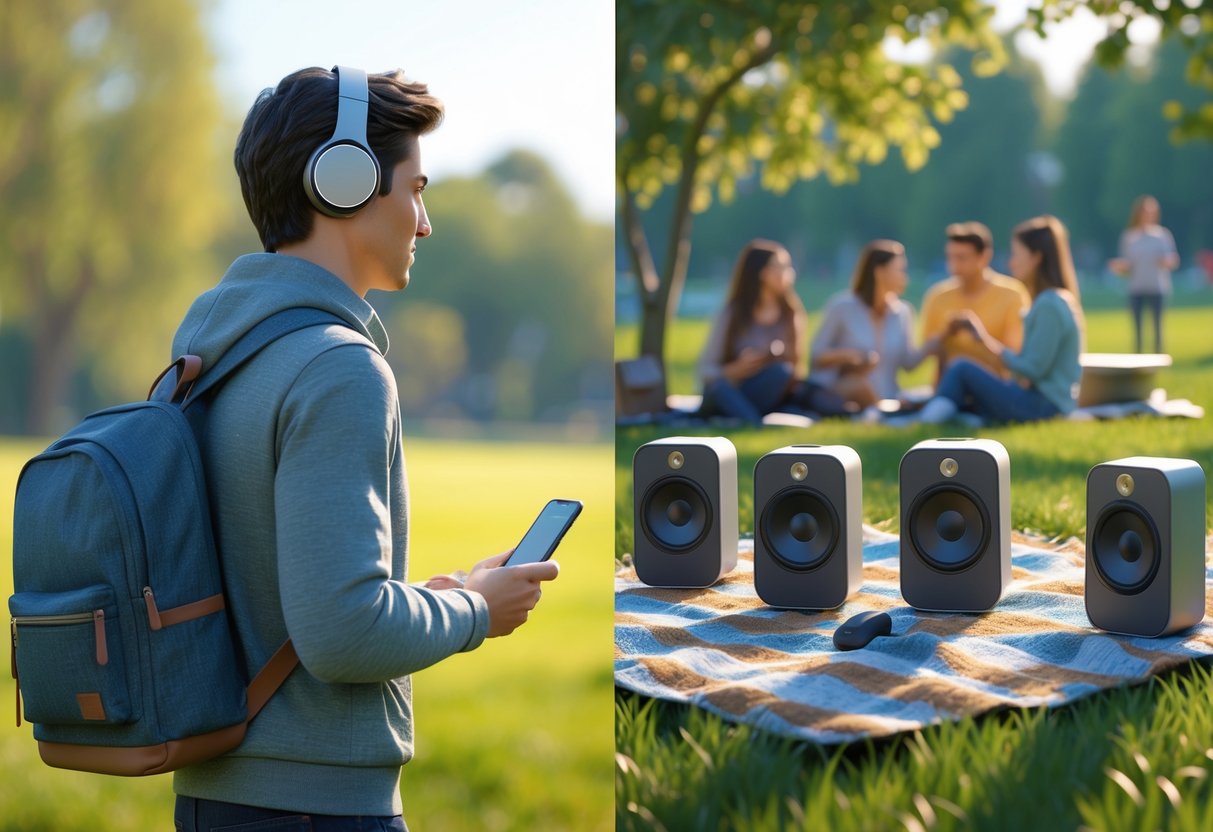
Headsets are the go-to for mobility, while speakers shine in shared spaces. Your pick really depends on whether you want personal audio freedom or group entertainment at home.
Listening on the Go
Headsets are built for moving around. You can toss them in a bag, sling them around your neck, or just carry them—no hassle. If you’re on the train or heading to a tournament, headsets keep your audio private.
Most headsets weigh 150-300 grams—lighter than a can of beans, honestly. You can wear them for hours and barely notice.
Speakers take more planning. Even portable Bluetooth ones need chargers, cases, and a bit more care. They’re just bulkier.
Headsets also keep things polite in public. You won’t bother anyone on the bus or wake up your flatmates with late-night gaming. That’s pretty important for not being “that person.”
A lot of headsets now come with noise cancellation. You can hear your music or game in noisy places without blasting the volume.
Quick tip: If you care about portability, grab a foldable headset.
In-Home Entertainment
Speakers bring people together. If your friends are over for an esports tournament or party game, everyone hears the action. No one’s left out.
You can set up speakers around your room for a better sound spread. This works great for Rocket League marathons or gaming nights.
Headsets put you in control. Adjust your own volume, swap sound profiles, or switch between game and Discord chat—no one else is affected.
Think about your living situation. Thin walls? Speakers might annoy the neighbors. In a shared flat, headsets are probably the safer bet for those late-night sessions.
Speakers are better for background music when you’re cleaning or working around the house. Headsets keep you tethered and can get uncomfortable if you wear them too long.
Honestly, both have their place. Lots of gamers own both and just swap depending on what they’re doing.
Budget and Value for Money
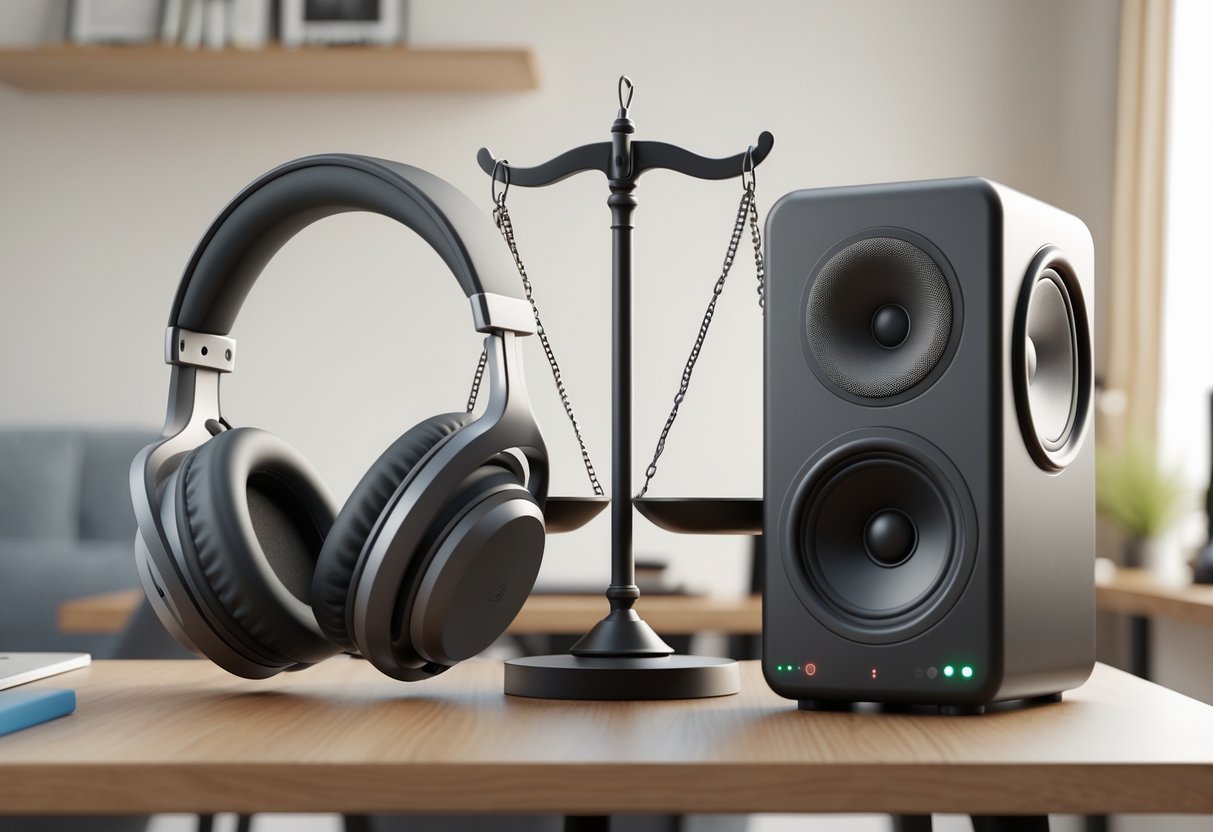
Headphones usually give you more for your money if you’re on a budget. Speakers cost more upfront, but they fill a room with sound. It all depends on what you want to spend and if you plan to upgrade down the line.
Cost of Entry
Getting started with headphones is cheap. You can find solid gaming headphones for £50-£100 that sound good for competitive play.
Speakers need a bigger investment. A basic 2.1 system runs £100-£200, and you might need an amp and more space.
Headphone budget:
- Entry: £30-£60 (basic headsets)
- Mid-range: £80-£150 (good sound, built-in mic)
- High-end: £200-£400 (audiophile-level)
Speaker budget:
- Basic 2.0: £60-£120
- 2.1 with sub: £100-£250
- Bookshelf + amp: £200-£500
For esports on a tight budget, headphones are the clear winner. You get better sound for less, plus you don’t wake up your housemates.
Upgrading and Expanding
Headphones hit their limit pretty quickly. Once you’ve got a nice pair, there’s not much to upgrade unless you just buy a new set.
Speakers are way more flexible. Start with bookshelf speakers, then add a sub, swap out your amp, or even treat your room for better sound.
Headphone upgrades:
- Swap the whole headset for something better
- Not much customization
- After £300, improvements get pretty minor
Speaker upgrades:
- Add a subwoofer for bass
- Upgrade your amp
- Expand to surround sound
- Room tweaks help everything
A lot of gamers start with headphones, then slowly build a speaker setup over time. That way you get good sound now and can save up for the big upgrade.
A killer speaker system can hit £2,000-£5,000, while even the fanciest gaming headphones rarely go past £500-£600.
Types of Headsets and Speakers
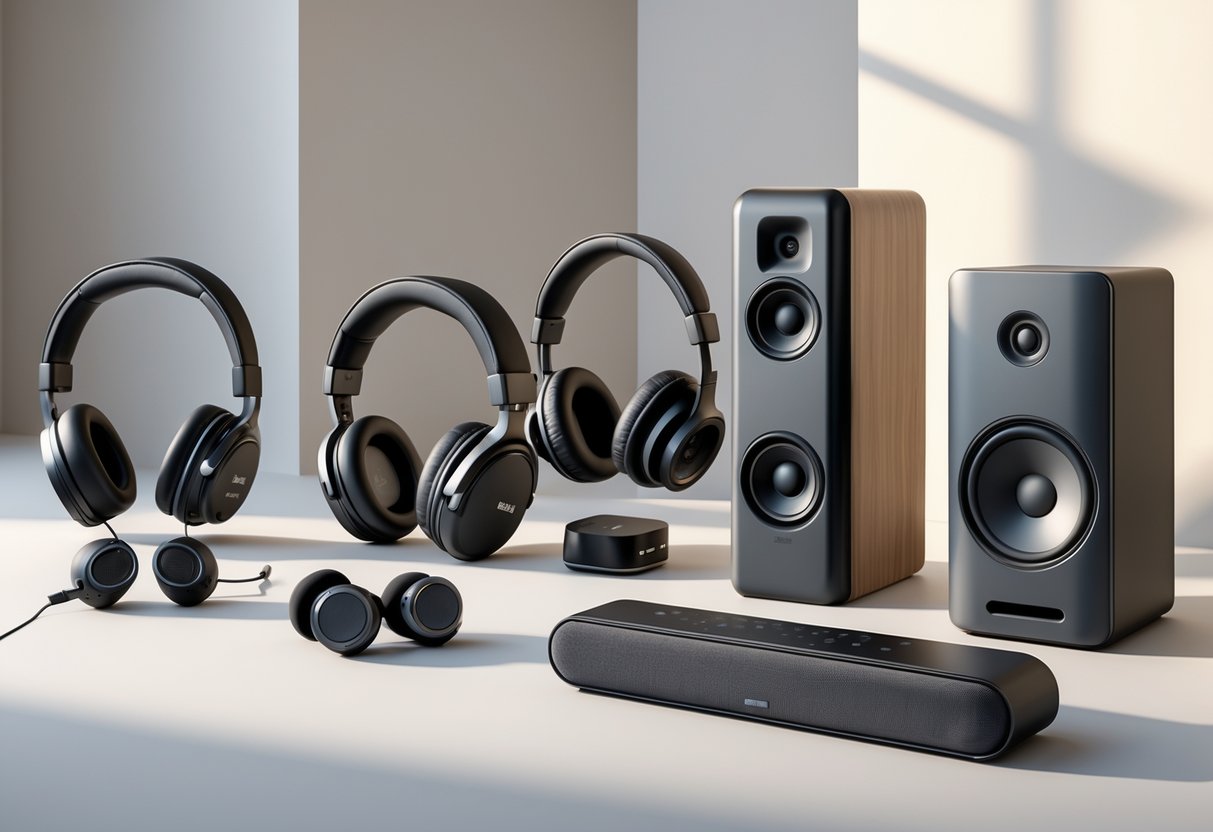
You’ll find headsets in both wired and wireless flavors, and each has its own pros and cons. Speakers go from basic stereo pairs to full-on subwoofer systems that can really shake your walls.
Wired vs Wireless Headsets
Wired headsets plug in through USB or a 3.5mm jack. They give you zero latency, which is crucial if you care about split-second timing.
Most wired gaming headsets cost £30-150. No batteries, no fuss—just plug and play.
The downside? Cables get in the way. It’s easy to yank them out during a heated match.
Wireless headsets use Bluetooth or 2.4GHz connections. The good ones—like the SteelSeries Arctis 7—use special dongles for nearly lag-free sound.
Battery life runs from 12 to 40 hours, depending on the model. High-end wireless sets cost £80-300.
Heads up: Cheap wireless headsets (under £40) often lag enough to ruin competitive games.
Wireless is awesome for single-player or casual gaming. But if you’re playing ranked matches or tournaments, wired is still the go-to.
Loudspeakers, Subwoofers, and Stereo Speakers
Stereo speakers are the backbone of any gaming audio setup. A decent pair costs £50-200 and gives you crisp dialogue and effects.
Put them at ear level, angled at your chair. Most connect by 3.5mm or USB.
Subwoofers handle the deep rumbles—explosions, engines, all that. They add a physical punch you can actually feel.
Gaming subwoofers go for £60-400. Stick them near your feet for the best kick.
Loudspeakers usually mean bigger bookshelf or tower speakers. These start at £150-800+ and need their own amp.
They’re great for immersive, single-player games, but not ideal for shared spaces or late-night gaming.
Quick win: Start with a good set of stereo speakers. Add a subwoofer later if you want more bass.
Room Acoustics and Placement
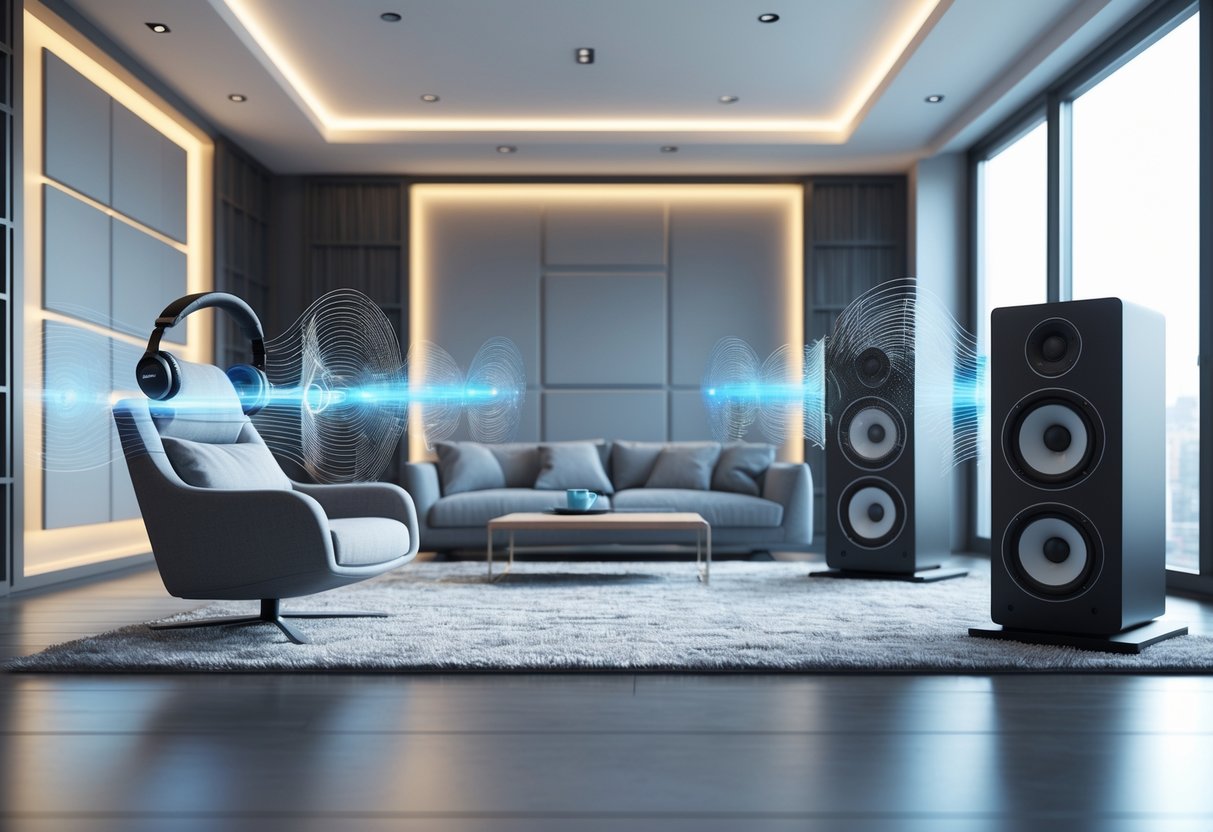
The room you’re in can totally change how speakers sound, but it doesn’t affect headphones at all. Speakers bounce sound off walls, floors, and furniture. Headphones send sound straight to your ears.
Effect on Speaker Performance
Your room changes your speakers’ sound in ways you might not expect. Hard walls and floors bounce sound around, which can create echoes and make things sound muddy.
Room shape matters. Square rooms can cause weird bass boosts or drops in certain spots. Rectangular rooms are usually easier to work with.
Here’s what affects speaker sound:
- Distance from walls – Too close and the bass gets boomy
- Corners – Put a speaker here and you’ll boost the bass (sometimes too much)
- Ceiling height – Low ceilings mean more reflections
- Furniture – Softer stuff soaks up sound, hard stuff bounces it
I’ve heard the same speakers sound amazing in one room and pretty bad in another. You really need to get placement right for good sound.
Speakers sound best at ear level, forming a triangle with your listening spot. Get this wrong and you lose out on stereo effects and clarity.
Adding carpets, curtains, or acoustic panels can help. But honestly, just moving your speakers away from walls can make a big difference.
No Room Interaction with Headphones
Headphones skip all the room issues since they sit right on your ears. The sound never hits the walls or ceiling.
That means you get the same sound quality whether you’re in a tiny bedroom or a big living room. Outside noise barely matters.
You don’t need to worry about where you sit with headphones. Stand, lie down, move around—it all sounds the same. Speakers make you stay in the “sweet spot” for the best experience.
This is super handy for gaming or late-night listening. Headphones give you a consistent sound, even in a noisy flat.
The trade-off? You lose the natural sense of space that speakers give. With headphones, everything happens inside your head instead of around you.
Price matters less for headphones, since the room can’t mess up the sound. A £200 pair will always sound like £200 headphones, while £200 speakers might sound pretty rough in the wrong room.
Listening Preferences and Practical Considerations
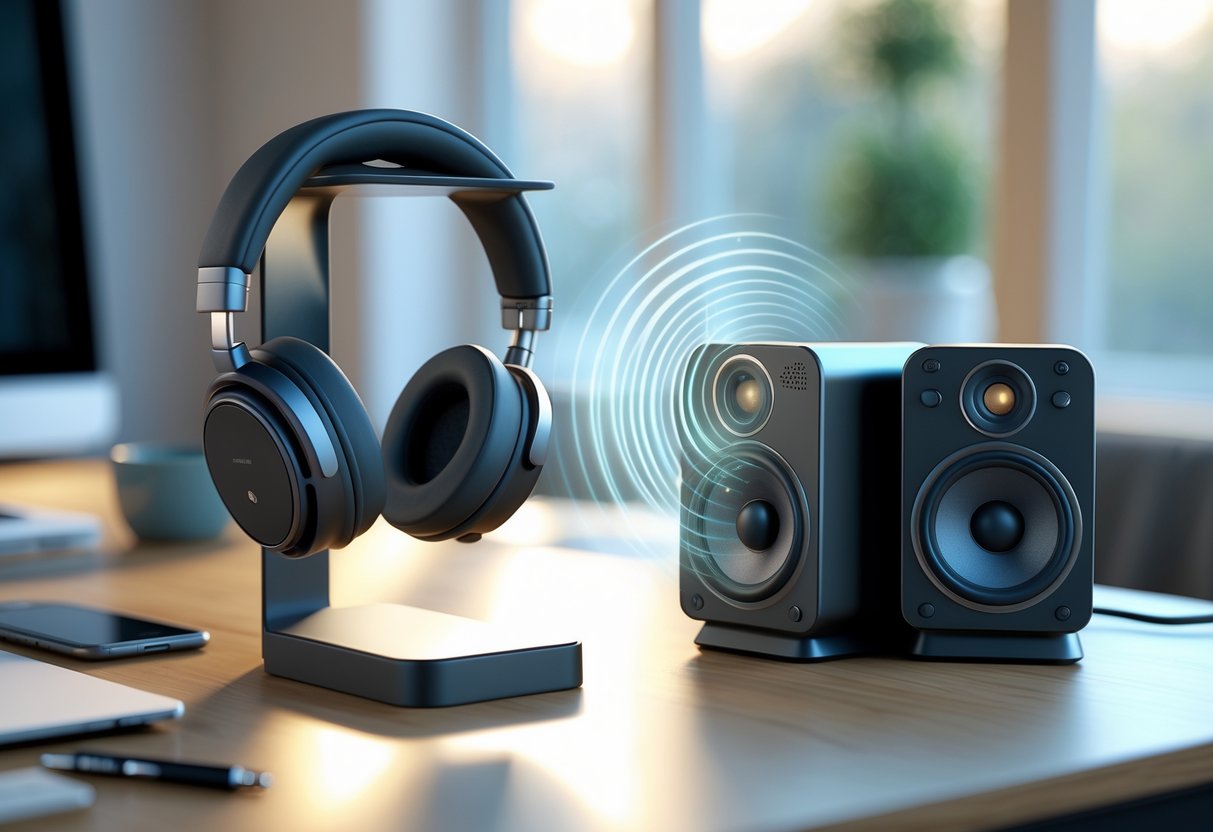
Your daily routine and personal habits really shape whether headphones or speakers fit you best. It usually depends on where you play, who you live with, and how you like to hear your games.
Personal Enjoyment and Lifestyle
Gaming alone or with others makes a big difference. If you’re a solo gamer who likes late-night sessions, headphones are probably your friend. You won’t wake up roommates or family.
A lot of gamers say headphones help them focus. You catch enemy footsteps in shooters without blasting the volume.
The isolation can help you zone in during tough matches.
Comfort matters a lot if you play for hours. Some folks get tired of headphones after a couple of hours. Others think speakers feel easier on the head, but admit you lose some audio detail.
Your living situation changes things, too. If you’re in shared housing, you’ll probably stick with headphones. But if you’ve got a dedicated room, speakers give you that big, open sound.
Budget comes into play as well. Good headphones usually cost less than a solid speaker setup. You don’t have to worry about amps or treating your room’s acoustics.
When to Choose Headset or Speakers
Go for headphones if:
- You play competitive games and need accurate audio cues
- You game in shared spaces or late at night
- You travel or game on laptops
- You’re on a tighter budget (under £200)
- You need a mic for team chat
Pick speakers if:
- You’ve got a dedicated gaming room
- You play single-player story games and want immersion
- You like sharing the experience with friends in person
- Headphones start to hurt during long sessions
- Your room lets you set up speakers properly
Mixing both works for a lot of people. Use headphones for serious online play, then switch to speakers for chill single-player games. It’s nice to have options depending on your mood or the hour.
Frequently Asked Questions
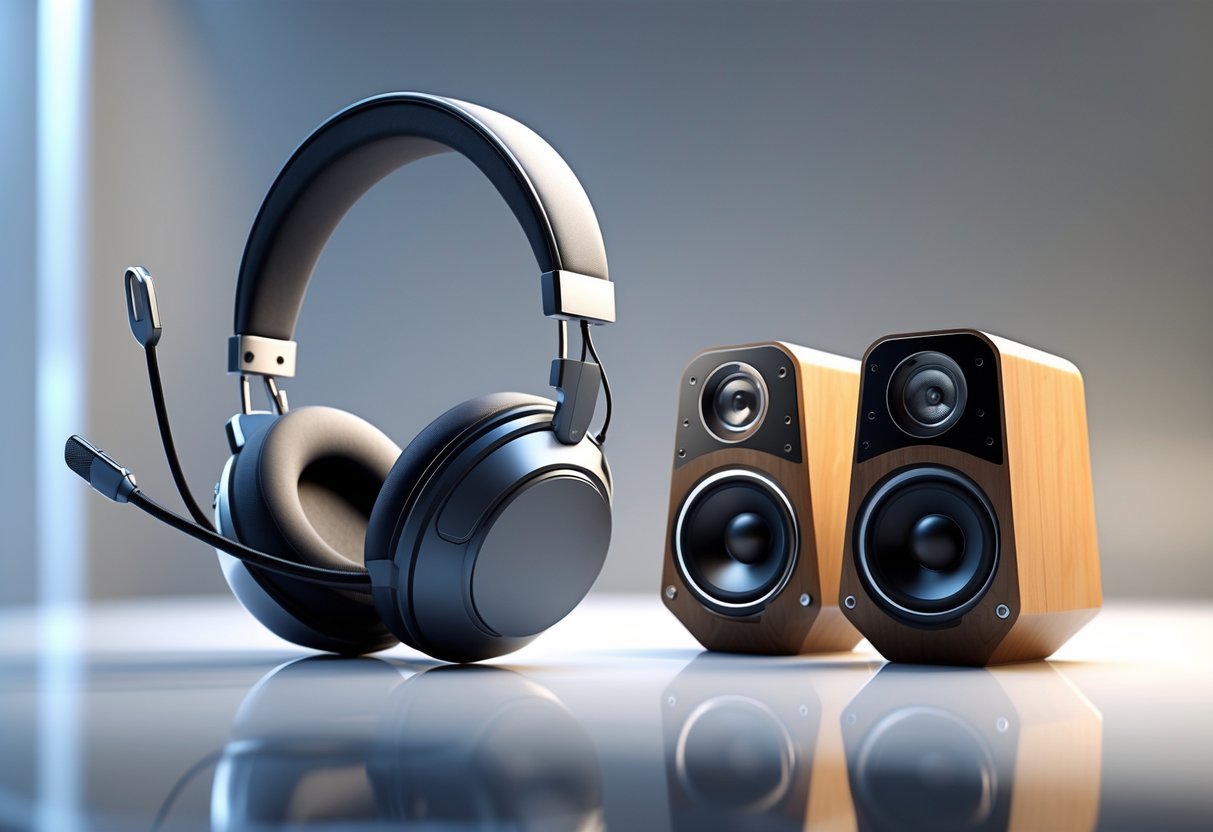
Gaming headphones give you a real edge with directional audio, especially in competitive matches. Speakers, on the other hand, make sharing the experience with others a lot more fun. The risk of hearing damage changes depending on how loud and how close the sound is, so you’ll want to think about that. Sometimes, you need a different audio solution for each situation.
What are the advantages of using headphones for gaming as opposed to speakers?
Headphones give you super precise directional audio. You’ll pick up on footsteps sneaking up behind you or figure out exactly where shots are coming from.
They also help you avoid bothering anyone else in the house during late-night sessions. Most gaming headsets come with built-in mics, so chatting with your team is easy.
The immersive experience can help you block out distractions. Speakers just can’t seal you off from background noise the same way.
How does the risk of hearing damage compare between headphones and speakers?
Headphones bring more risk since they sit right on your ears. Sudden loud sounds can hurt more quickly than if you’re listening to speakers across the room.
Speakers spread sound out, so your ears take less of a direct hit. Still, if you blast either one for too long, you can do damage.
Try following the 60/60 rule: keep the volume under 60% and take breaks after 60 minutes. No matter what you use, give your ears a rest.
Can you recommend a device that combines headphones and speakers in one?
Honestly, there isn’t a device that does both well. Headphones and speakers need different designs to sound their best.
Some gaming chairs have built-in speakers, but they usually sound pretty bad compared to real speakers or headphones. Those “convertible” headphones that turn into speakers? They don’t really impress in either mode.
You’re better off getting a decent pair of headphones and a basic set of speakers. That way, you don’t have to settle for less on both fronts.
In what scenarios might open-back headphones be preferable to using speakers?
Open-back headphones work great when you want a wide, open sound but can’t use speakers. They give you that natural feel without filling the whole room with noise.
They’re perfect for long music sessions if you want to stay aware of what’s happening around you. You’ll still hear someone calling your name or the doorbell, unlike with closed-back headphones.
Open-back designs can also help cut down on ear fatigue during marathon sessions. The airflow keeps things from getting too stuffy.
For an audiophile, what are the main considerations when choosing between headphones and speakers?
Headphones and speakers each have their own strengths. Headphones usually give you more detail and a close-up listening experience. Speakers, though, create a natural soundstage that fills the room.
Your space really matters. Bad room acoustics can ruin even the best speakers, while headphones just skip that problem. But headphones might need a good amp to sound their best.
Budgeting is different, too. Entry-level audiophile headphones often cost less than a full speaker system, especially when you add in amps, stands, and room treatment.
When watching movies, what benefits do headphones offer over speakers?
Headphones give you crystal-clear dialogue without bothering anyone else. They’re a lifesaver for late-night movies or if you share your space with others.
You’ll catch every whisper and subtle sound effect—stuff that regular speakers sometimes just can’t deliver.
With headphones, you don’t have to mess with dynamic range compression. Quiet scenes stay clear, and you won’t have to worry about a sudden explosion waking up the whole house.
You also get to skip the annoying volume adjustments.
A lot of headphones do a surprisingly good job at creating a surround sound feel from movie soundtracks. Virtual surround processing can make a laptop or tablet sound way more like a movie theater than you’d expect.

